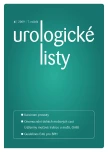THE TREATMENT OF THE OVERACTIVE BLADDER IN FEMALE PATIENTS
Authors:
J. Krhut; O. Havránek
Authors‘ workplace:
Urologické oddělení FN Ostrava – Poruba
Published in:
Urol List 2009; 7(4): 55-58
Overview
The term of overactive bladder (OAB) indicates complex of symptoms of urgency, with or without urge incontinence and it is usually accompained by frequency and nocturia. OAB is one of the most common medical conditions with an estimated 16 percent of adult population being affected in Europe. Lot of attention is paid to this problem recently from many points of view because of significant impact on quality of life. The aim of this paper is to present an overwiev of new findings from pathophysiology, diagnostics and treatment of the overactive bladder.
Key words:
overactive bladder, muscarinic receptors, pharmacotherapy, anticholinergics
Sources
1. Milsom I, Abrams P, Cardozo L et al. How widespread are the symptoms of an overactive bladder and how are they managed? A population-based prevalence study. BJU Int 2001; 87(9): 760–766.
2. Stewart WF, van Rooyen JB, Cundiff GW et al. Prevalence and burden of overactive bladder in the United States.World J Urol 2003; 20(6): 327–336.
3. Milsom I. Lower urinary tract symptoms in women. Curr Opin Urol 2009; 19(4): 337–341.
4. Zachoval R, Krhut J, Zámečník L et al. Dotazníky hodnotící kvalitu života u pacientů s inkontinencí moči a hyperaktivním měchýřem. Urolog pro Praxi 2006; 7(6): 286–292.
5. Klutke CG, Burgio KL, Wyman JF et al. Combined effects of behavioral intervention and tolterodine in patients dissatisfied with overactive bladder medication. J Urol 2009; 181(6): 2599–2607.
6. Yamaguchi O. Antimuscarinics and overactive bladder: other mechanism of action. Neurourol Urodyn 2009 Aug 19. [Epub ahead of print]
7. Yarker YE, Goa KL, Fitton A. Oxybutynin. A review of its pharmacodynamic and pharmacokinetic properties, and its therapeutic use in detrusor instability. Drugs Aging 1995; 6(3): 243–262.
8. Appell RA. Efficacy and safety of transdermal oxybutynin in patients with urge and mixed urinary incontinence. Curr Urol Rep 2003; 4(5): 343.
9. Riotte J, Mutschler E. Untersuchungen zur Spasmolytischen Aktivität von Propiverin und einigen seiner Strukturanaloga. Arzneimittelforschung 1987; 37: 300–302.
10. Halaška M, Dorschner W, Frank M. Treatment of urgency and incontinence in elderly patients with propiverine hydrochloride. Neurourol Urodyn 1994; 13: 428–430.
11. Jünemann KP, Halaska M, Rittstein T et al: Propiverine versus tolterodine: efficacy and tolerability in patients with overactive bladder. Eur Urol 2005; 48(3): 478–482.
12. Pietzko A, Dimpfel W, Schwantes U et al. Influences of trospium chloride and oxybutinin on quantitative EEG in healthy volunteers. Eur J Clin Pharmacol 1994; 47(4): 337–343.
13. Herberg K-W. Alltags- und Verkehrssicherheit unter Inkontinenz-Medikation: Neue Untersuchungen zum Sicherheitspotential urologischer Anticholinergika. Med Welt 1999; 50: 217–222.
14. Madersbacher H, Ahnig L, Rettig K. Reizblasensymptomatik und Harndranginkontinenz – wirksame Therapie mit Spasmo – lyt – Dragees. Allgemeinarzt 1995; 17: 501–503.
15. Nitti VW, Dmochowski R, Sand PK et al. Efficacy, safety and tolerability of fesoterodine for overactive bladder syndrome. J Urol 2007; 178(6): 2488–2494.
16. Chapple CR, van Kerrebroeck PE, Jünemann KP et al. Comparison of fesoterodine and tolterodine in patients with overactive bladder. BJU Int 2008; 102(9): 1128–1132.
17. Ikeda K, Kobayashi S, Suzuki M et al. M(3) receptor antagonist by the novel antimuscarinic agent solifenacin in the urinary bladder and salivary gland. Naunyn Schmiedebergs Arch Pharmacol. 2002; 366(2): 97–103.
18. Chapple CR, Cardozzo L, Steers WD et al Solifenacin significantly improves all symptoms of overactive bladder syndrome. Int J Clin Pract 2006; 60(8): 959–966.
Labels
Paediatric urologist UrologyArticle was published in
Urological Journal

2009 Issue 4
Most read in this issue
- Intraoperational course, early complications and functional outcome in robotic-assisted AND OPEN RADICAL PROSTATECTOMY – A COMPARISON
- SURGICAL ANATOMY OF THE PROSTATE & PELVIC FLOOR FOR THE PERFORMANCE OF RADICAL PROSTATECTOMY & RADICAL CYSTECTOMY: CRITICAL POINTS FOR ACHIEVING THE TRIFECTA OF ONCOLOGIC SAFETY, URINARY CONTROL, AND ERECTILE FUNCTION
- ROBOTIC-ASSISTED LAPAROSCOPIC PROSTATECTOMY: A CRITICAL ASSESSMENT OF OUTCOMES
- TRANSITION OF WHOLE GLAND CRYOSURGERY TO FOCAL CRYOABLATION FOR THE TREATMENT OF EARLY STAGE LOCALIZED PROSTATE CANCER
